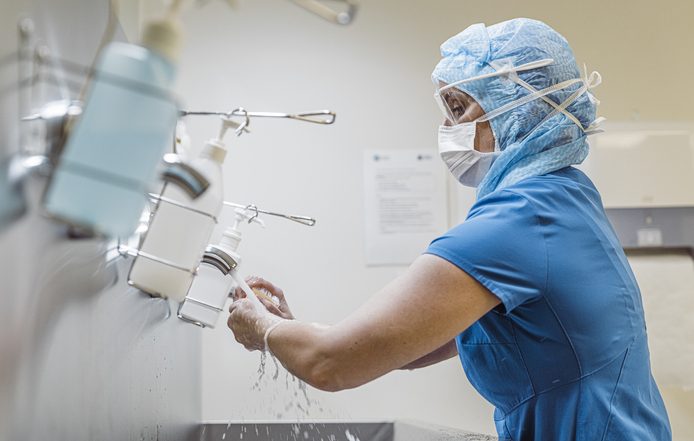Combating an unprecedented global pandemic.
The novel coronavirus 2019, was first reported on in Wuhan, China in late December 2019. The outbreak was declared a public health emergency of international concern in January 2020.
With the latest update just this month, the world health organization stated this is a worldwide pandemic. As the rate of publications of SARS-CoV-2 is much like the speed and scale of transmission of the virus itself — almost impossible to keep up with.
In this piece, I want to leave you with eight thoughts on COVID-19.
- The virus has been named SARS-CoV-2 and the disease it causes has become known as coronavirus disease 2019 (COVID-19). I see these two used interchangeably so wanted to clarify the terminology.
- In one study [1], of 138 hospitalized patients with confirmed novel coronavirus infected PNA (NCIP), the rate of hospital-associated transmission was 29% in active health care workers and 12.0% in hospitalized patients. This suggests a 41% nosocomial spread. Be up to date with what personal protective equipment is required, as well as donning and doffing procedures.
- The Diamond Princess cruise ship [2] gives us great insight into COVID-19 in an isolated environment. R0, pronounced R nought, is a way of saying one case of a disease will potentially spread to how many others. Of 3,711 people on board, 355 cases had confirmed COVID-19, which is an R0 of 2.28. Of the 355 cases, seven people died, which equates to a case fatality rate of 1.9%.
- Widely available respiratory viral panels test only for earlier forms of human Coronavirus, but not SARS-CoV, MERS-CoV, and COVID-19 strains, which require more specialized assays.
- The CDC recommends a lower respiratory tract sample such as induced sputum or bronchoalveolar lavage for the RT-PCR. In my opinion, this should not be done as this can aerosolize virus. A nasopharyngeal or throat swab should suffice.
- Surgical masks can prevent the person wearing the mask from spreading large sprays or droplets as well as preventing hand-to-face contact, but do not prevent people from acquiring COVID19
- One effective strategy to offload EDs is decentralized testing away from hospitals/EDs. (i.e. tents outside the hospital to screen patients, drive through tents, fever clinics, etc…). Here is a link to ACEP’s summary on EMTALA from CMS COVID19 guidance: https://rebelem.com/wp-content/uploads/2020/03/CMSs-March-9th-COVID-19-EMTALA-Guidance.pdf
- We still need more follow-up studies to further evaluate the safety and health of pregnant women and newborn babies who develop COVID-19 infection, but there is one retrospective case series of nine pregnant patients [3] with laboratory-confirmed COVID-19 pneumonia. In this study, all nine mothers had Caesarean section in their third trimester and none of the mothers developed severe pneumonia, requiring mechanical ventilation or died of COVID-19 PNA. None of the nine neonates died in this series either. Finally, amniotic fluid, cord blood, neonatal throat swabs, and breastmilk samples were tested from six of the nine patients and all samples tested were negative for the virus (i.e. no vertical transmission)
Finally, COVID-19 does not discriminate against any person on the basis of race, color, national origin, religion or creed. It is now a pandemic and is most likely not going away anytime soon. We need to arrest this crisis before the impossible becomes necessary (i.e. wartime triage…don’t believe me, just take a look at Italy).
The goal over the coming weeks is to “soften the curve” so that the U.S. does not see the drastic spike in cases that have been experienced in China, Italy and other countries. This will allow for the U.S. to catch up on testing and hopefully limit and disperse the burden on our medical system.
According to the American Hospital Association’s 2020 data [4], the U.S. has approximately 100,000 critical care beds and much of that capacity is utilized during normal operations. While estimates vary widely on the possible U.S. impact both in number and severity, it is clear that our hospital systems are at risk for being overwhelmed.
The time is now, if ever to reduce the impact of the illness by social distancing. The best way to do this is stopping gatherings of people (i.e. conferences, sporting events, etc) and restricting travel. This is all of our social responsibility. The sooner we do this the more we can drive down fatality rates and the better healthcare systems can function until treatment/vaccination are possible.
References:
- Wang D et al. Clinical Characteristics of 138 Hospitalized Patients with 2019 Novel Coronavirus-Infected Pneumonia in Wuhan, China. JAMA 2020.PMID: 32031570
- Zhang Sheng et al. Estimation of the Reproductive Number of Nobel Coronavirus (COVID-19) and the Probable Outbreak Size on the Diamond Princess Cruise Ship: A Data-Driven Analysis. Int J Infect Dis 2020. PMID: 32097725
- Chen H et al. Clinical Characteristics and Intrauterine Vertical Transmission Potential of COVID-19 Infection in Nine Pregnant Women: A Retrospective Review of Medical Records. Lancet 2020 [Epub Ahead of Print]
- American Hospital Association. 2020. Fast Facts On U.S. Hospitals, 2020 | AHA. [online]Available at: <https://www.aha.org/statistics/fast-facts-us-hospitals> [Accessed 14 March 2020].








